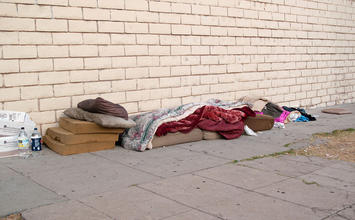
Americans are enjoying summer, lighting up the barbeque, enjoying the freedom of flip-flops, and thinking about weekend road trips with the family. It’s also the time of year when cities sneak out their annual homeless counts.
This year the numbers are particularly grim. The Los Angeles Homeless Services Authority (LAHSA) reported in June that homelessness increased by 16% in the city and 12% in the county between 2018-19. According to the official count there were 36,300 homeless people in the city and 58,936 in the county at the time of the count. Overall LAHSA estimated that 100,000 people experienced homelessness in the county in 2018. The news is equally disheartening elsewhere: San Francisco reported a 17% increase, while communities in Ventura, Kern, and San Bernardino Counties saw more than 20% increases. Even where the news is less dire there is cause for alarm. New York, which spends some $2 billion annually on homelessness, barely managed a 1.3% reduction.
Yet even these troubling numbers are likely wrong. That’s because the nation’s annual local homeless count, called a point in time (PIT) count, is deeply flawed. Department of Housing and Urban Development (HUD) guidelines exclude people doubled up with family, couch surfing, or in a hospital or mental health facility. Many shelters run by nonprofits and faith organizations have rigorous privacy rules that make it all but impossible to identify who lives there. Yet as many as three quarters of homeless people have some form of shelter at any given time, meaning the count misses them. Volunteers can’t enter buildings or knock on doors. A volunteer in Queens could pass a warehouse occupied by a dozen people, and it wouldn’t register. Count accuracy can even be affected by bureaucratic paperwork snafus.
Moreover, many homeless people won’t admit their situation. Dr. Hattie Mitchell, founder and CEO of Crete Academy, a charter in south Los Angeles that serves homeless families, asks rhetorically, “Parents often won’t tell extended family about their situation. Will they tell a stranger with a clipboard?”
Volunteers are poorly equipped to compensate for the problems. They receive an hour or two of training then fan out into their communities, using their own judgment in determining who is and isn’t homeless. Elliot Hannah is the president of the Mar Vista Community Council in west L.A. He volunteered for the counts in 2016 and 2017. He identified a number of problems firsthand, most significantly poor coordination. “We could be counting people on a street that another group of volunteers already covered, and we’d never know it.”
Further complicating the task are inconsistent federal, state, and local definitions of homelessness. HUD’s own website cautions, “since compliance with these standards may vary, the reliability and consistency of the homeless counts may also vary.” Localities have discretion as to how they count. For example, Philadelphia conducts its count over five and a half hours on a single night. In New York and San Francisco the counts last one day. In Los Angeles it takes three days. HUD guidelines sometimes change, making year-to-year comparisons almost impossible.
The PIT count is a “snapshot,” says Lorin Kinney, a Senior Analyst with the Los Angeles Homeless Services Agency. “We count individuals who are either living on the street or otherwise in places not meant for human habitation.”
Certainly, it’s useful for officials to ascertain how many people are homeless at any given time. The problem is that while the snapshot tells only part of the story, it drives homeless policies. HUD uses PIT numbers in funding decisions, while local officials use them as policy benchmarks. Media take the numbers at face value, meaning they set public perception.
In a word, that perception is wrong. In Chicago the 2018 PIT count found 5,400 homeless people. However, the Chicago Coalition for the Homeless estimated that 80,000 people experienced homelessness in the windy city. According to the Bowery Mission, New York’s count may capture just 1 in 17 homeless. The numbers also swing wildly year to year. Between 2016 and 2017 New York recorded a 40% increase in homelessness. Between 2017 and 2018, it was a 6% decrease.
Homeless children are particularly undercounted. In 2017 L.A. identified 5,091 children. Yet the California Department of Education, using data collected at the campus level by federally mandated homeless liaisons, set the number at 52,975. The Los Angeles County Office of Education, applying an even broader definition, estimated that some 72,000 students experienced homelessness that year.
What’s more, neither number may tell the full story. A 2014 report from the National Center on Family Homelessness at the American Institutes for Research estimated that 526,708 children were homeless at some time in California in 2013. One in four Californians live in Los Angeles County, suggesting that as many as 131,677 children experienced homelessness in L.A. that year. And that was six years ago, before the problem truly spiraled.
African Americans, Latinos, and Native Americans are more likely to experience homelessness, yet they are the most undercounted cohorts. Colleen Echohawk is Executive Director of the Chief Seattle Club, a nonprofit that provides support to the eponymous city’s Native populations. She describes homeless Native Americans as the invisible among the invisible. “Native people are extremely good at hiding themselves. If they don’t want to be found, they won’t be.”
Politicians nationwide talk of homeless crises in their communities, but it’s a crisis decades in the making. A June 1990 Wall Street Journal story identified the same issues scholars and journalists point out today. Unless and until officials, starting with HUD, devise methods that capture the true scope of the crisis solutions will remain elusive.
Christopher LeGras is an attorney and journalist in Los Angeles.
Photo credit: Downtowngal [CC BY-SA 3.0], via Wikimedia Commons












